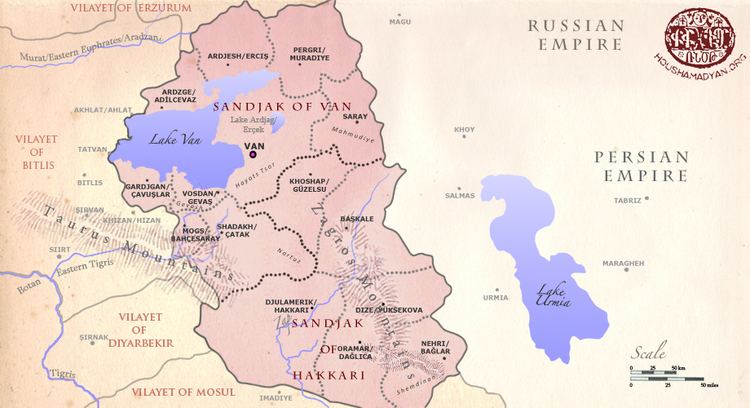 | ||
How to say vilayets high quality voices
The Vilayets ([vilaːˈjet]) of the Ottoman Empire were the first-order administrative division, or provinces, of the later empire, introduced with the promulgation of the Vilayet Law (Turkish: Teşkil-i Vilayet Nizamnamesi) of 21 January 1867. The reform was part of the ongoing administrative reforms that were being enacted throughout the empire, and enshrined in the Imperial Edict of 1856. The reform was at first implemented experimentally in the Danube Vilayet, specially formed in 1864 and headed by the leading reformist Midhat Pasha. The reform was gradually implemented, and not until 1884 was it applied to the entirety of the Empire's provinces.
Contents
- How to say vilayets high quality voices
- Mamuret ul aziz vilayet
- Etymology
- Administrative division
- Labelled Map
- Vilayets sanjaks and autonomies c 1876
- Vilayets and independent sanjaks in 1917
- Encyclopdia Britannica on the late Ottoman administration
- References
Mamuret ul aziz vilayet
Etymology
The term vilayet is derived from the Arabic word wilayah or wilaya. While in Arabic, the word wilaya is used to denote a province or region or district without any specific administrative connotation, the Ottomans used it to denote a specific administrative division.
Administrative division
The Ottoman Empire had already begun to modernize its administration and regularize its provinces (eyalets) in the 1840s, but the Vilayet Law extended this to the entire Ottoman territory, with a regularized hierarchy of administrative units: the vilayet, headed by a vali, was subdivided into sub-provinces (sanjak) under a mütesarrif, further into districts (kaza or liva) under a kaimakam, and into communes (nahiye) under a müdir.
The vali was the representative of the Sultan in the vilayet and hence the supreme head of the administration. He was assisted by secretaries in charge of finances (defterdar), correspondence and archives (mektubci), dealings with foreigners, public works, agriculture and commerce, nominated by the respective ministers. Along with the chief justice (mufettiş-i hukkam-i Şeri'a), these officials formed the vilayet's executive council. In addition, there was an elected provincial council of four members, two Muslims and two non-Muslims. The governor of the chief sanjak (merkez sanjak), where the vilayet's capital was located, deputized for the vali in the latter's absence. A similar structure was replicated in the lower hierarchical levels, with executive and advisory councils drawn from the local administrators and—following long-established practice—the heads of the various local religious communities.
Labelled Map
Vilayets of the Ottoman Empire circa 1885:
Vilayets, sanjaks and autonomies, c. 1876
Vilayets, sanjaks and autonomies, circa 1876:
Vilayets and independent sanjaks in 1917
Vilayets and independent sanjaks in 1917:
Encyclopædia Britannica on the late Ottoman administration
For administrative purposes the immediate possessions of the sultan are divided into vilayets (provinces), which are again subdivided into sanjaks or mutessarifliks (arrondissements), these into kazas (cantons), and the kazas into nahies (parishes or communes). A vali or governor-general, nominated by the sultan, stands at the head of the vilayet, and on him are directly dependent the kaimakams, mutassarifs, deftardars and other administrators of the minor divisions.
All these officials unite in their own persons the judicial and executive functions, under the " Law of the Vilayets," which made its appearance in 1861, and purported, and was really intended by its framers, to confer on the provinces a large measure of self-government, in which both Mussulmans and non-Mussulmans should take part. It really, however, had the effect of centralizing the whole power of the country more absolutely than ever in the sultan's hands, since the Valis were wholly in his undisputed power, while the ex officio official members of the local councils secured a perpetual Mussulman majority.
